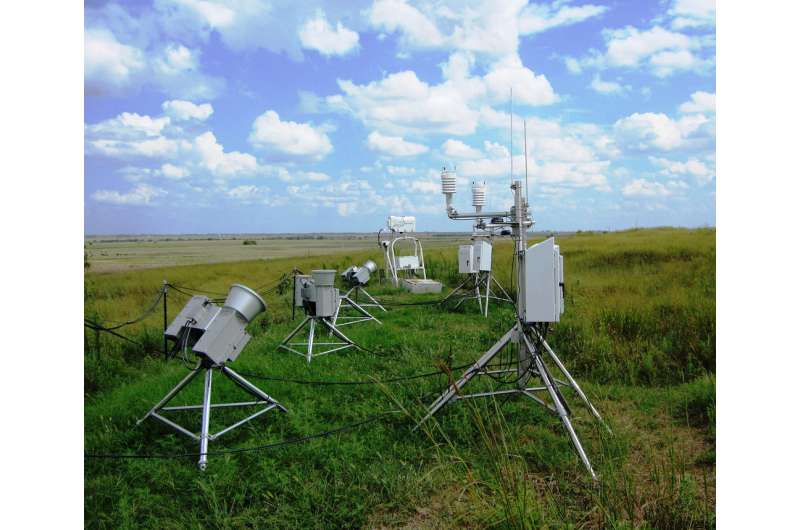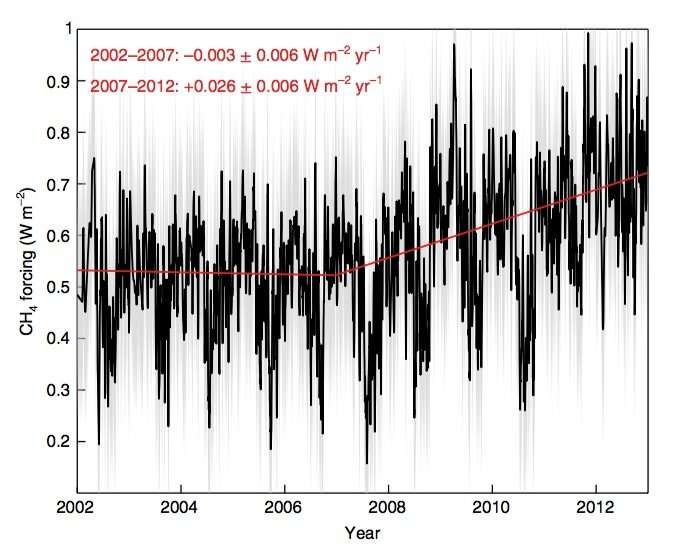First direct observations of methane's increasing greenhouse effect at the Earth's surface

Scientists have directly measured the increasing greenhouse effect of methane at the Earth's surface for the first time. A research team from the U.S. Department of Energy's Lawrence Berkeley National Laboratory (Berkeley Lab) tracked a rise in the warming effect of methane - one of the most important greenhouse gases for the Earth's atmosphere - over a 10-year period at a DOE field observation site in northern Oklahoma.
These findings were published online April 2 in the journal Nature Geoscience in an article entitled "Observationally derived rise in methane surface forcing mediated by water vapour trends." The paper indicates that the greenhouse effect from methane tracked the global pause in methane concentrations in the early 2000s and began to rise at the same time that the concentrations began to rise in 2007.
"We have long suspected from laboratory measurements, theory, and models that methane is an important greenhouse gas," said Berkeley Lab Research Scientist Dan Feldman, the study's lead author. "Our work directly measures how increasing concentrations of methane are leading to an increasing greenhouse effect in the Earth's atmosphere."
Gases that trap heat in the atmosphere are called greenhouse gases, in large part because they absorb certain wavelengths of energy emitted by the Earth. As their atmospheric concentrations change, the scientific community expects the amount of energy absorbed by these gases to change accordingly, but prior to this study, that expectation for methane had not been confirmed outside of the laboratory.

The scientists analyzed highly calibrated long-term measurements to isolate the changing greenhouse effect of methane. They did this by looking at measurements over the wavelengths at which methane is known to exert its greenhouse effect and coupled those with a suite of other atmospheric measurements to control for other confounding factors, including water vapor.
This study was enabled by the comprehensive measurements of the Earth's atmosphere that the DOE has routinely collected for decades at its Atmospheric Radiation Measurement (ARM) facilities, and conversely, would not be possible without such detailed observations.
The DOE ARM program manages and supports three long-term atmospheric observatories - the Southern Great Plains observatory in Oklahoma, the North Slope of Alaska observatory in far-northern Alaska, and the Eastern North Atlantic observatory on the Azores Islands. The program also deploys three ARM mobile facilities and several ARM aerial facilities. Together, these assets enable scientists to perform highly-detailed, targeted investigations to advance the fundamental scientific understanding of the Earth system.
The researchers believe this type of direct field observation can provide a more accurate and complete picture of the relationship between atmospheric greenhouse gas concentrations and their warming effect on Earth's surface.
More information: Observationally derived rise in methane surface forcing mediated by water vapour trends, Nature Geoscience (2018). nature.com/articles/doi:10.1038/s41561-018-0085-9
Journal information: Nature Geoscience
Provided by Lawrence Berkeley National Laboratory




















